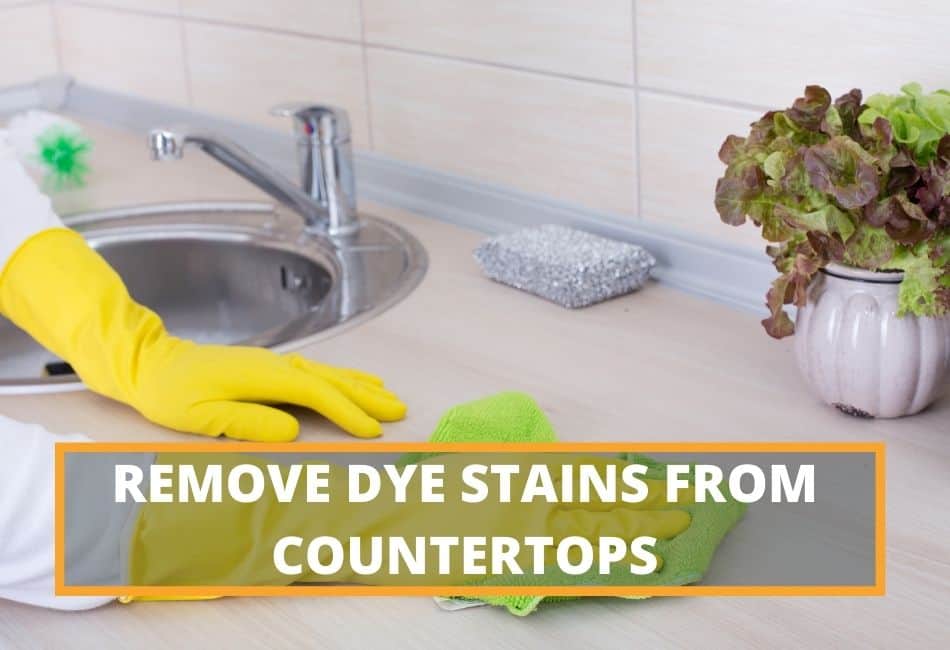We use products that contain dye on a daily basis, from our food to our clothes and hair. Some of these products include some food and drinks, candles, and cleaning supplies. While most of these products won’t cause any harm to our countertops, there are some that can leave tough stains.
Actual dyes such as hair dye and food coloring can be some of the most difficult to remove. While we love the way these products work, sometimes they can leave behind unsightly stains.
Whether you’re using store-bought dye or trying out a new DIY recipe, accidents happen and hair dye can end up on your countertops. In this article, we will discuss the best methods for
- Removing dye stains from laminate countertops
- Removing dye stains from marble countertops
- Removing dye stains from quartz countertops, and
- Removing dye stains from granite countertops.
We will also cover some tips on how to prevent these stains from happening in the first place. So read on and find out how you can get rid of those pesky stains.
For all countertops, the first solution to removing dye stains from countertops is to use a damp clot or sponge with dishwashing liquid and water immediately after the dye spillage occurs. Gently rub the area with the damp cloth until the stain lifts. If this does not work or if the dye has already set, you can try one of the following solutions depending on the type of countertop you have.
Caution: Do not use oven cleaners on any countertop material. It’ll cause more damage than good.
How To Remove Dye Stains From Laminate Countertops
Laminate countertops are a popular choice for many homeowners because it has a wide range of colors and designs, it is durable and easy to clean. Laminate is a type of plastic that is made to look like stone or wood. Laminate countertops are less likely to stain than other types of countertops, but if a dye does manage to get on it, there are a few ways to remove the stain. It is true they are durable but they are not as durable as some of the other countertop materials so when removing dye stains from laminate countertops, you will want to use a gentler solution.
Things You’ll Need:
- A clean cloth
- Rubbing alcohol
- Water
- Baking soda
- A soft-bristled brush
Steps To Remove Dye Stains From Laminate Countertops
- Start by blotting up any excess dye with a clean cloth. Be sure not to rub the stain, as this will only spread it further.
- Soak a cloth in rubbing alcohol and dab it onto the stain. Rub the area in a circular motion until the stain starts to lift. If the stain sets on the laminate countertop for a long time, rubbing alcohol might not be strong enough to remove all the stains. In this case, you can use a mixture of water and baking soda.
- Make a paste with the baking soda and water and apply it to the stain and allow it to sit for about 30 minutes. Do not apply it on unstained surfaces because it might also discolor or dull your countertop, especially if it is a colored countertop. To be sure if it is not too harsh on your laminate countertop, apply it to a small area first.
- Gently Rub the area with a soft-bristled brush until the stain lifts. Do not rub too hard or you could damage the countertop.
- Once the stain is gone, rinse the area with water and dry it off with a clean cloth.
- If there is any dullness or discoloration, you can paint over it to cover it up.
How To Remove Dye Stains From Marble Countertops
Marble countertops are a luxurious addition to any home. They bring a touch of elegance and sophistication. Marbles are natural stones that are found in different parts of the world. They are available in a wide range of colors, from classic white to deep black.
Because marble is a natural stone, it is more porous than other materials like quartz. This means that it can absorb liquids, which can lead to staining easily. Therefore if there is a dye spillage on marble countertops, you will want to take care of it right away.
Things You’ll Need:
- A clean cloth
- Hydrogen peroxide/Isopropyl alcohol
- Baking soda/Talcum powder
- Plastic wrap
- Masking tape
Steps To Remove Dye Stains From Marble Countertops
- Start by saturating the cloth with hydrogen peroxide or alcohol and blot the area until it is cleaned off. In some instances, this might be enough to remove the stain. If it is not, you can proceed to the next step.
- Make a paste with baking soda or talcum powder and hydrogen peroxide or Isopropyl alcohol. The mixture shouldn’t be too runny. To gauge the thickness, think of the consistency of toothpaste.
- Apply the paste to the stain and cover it with plastic wrap. Tape the edges down so that the mixture stays in place. Do not use strong tape because you don’t want the tape staining your countertop as well.
- Allow the mixture to sit on the stain overnight. The longer it sits, the better chance it has of removing the stain.
- Remove the plastic wrap and paste and wipe away with a clean damp cloth.
- If the stain is still present, you can repeat the process until it is removed. You can also use acetone instead of alcohol but be sure to test it on a small area first as it might damage your marble countertop.
How To Remove Dye Stains From Quartz Countertops
If you have a quartz countertop, you’ll be happy to know that it is one of the easiest surfaces to clean and is also one of the most resistant surfaces to staining. Quartz is one of the hardest minerals, so it is very durable. It is also non-porous, which means that liquids will not be able to penetrate the surface and cause staining.
However, if there is a dye spillage on your quartz countertop, you will want to take care of it right away as it can still cause a stain. Using dish soap and water will usually do the trick in removing the stain.
If the dish soap and water method don’t work, you can use baking soda. Baking soda is great for removing stubborn stains on quartz countertops.
Things needed:
- Baking soda
- Cleaning cloth
- Water
Steps To Remove Dye Stains From Quartz Countertops
- Mix equal parts baking soda and water to create a paste. The mixture shouldn’t be too watery.
- Apply the paste to the dye stain and allow it to sit for some time.
- Wipe away the paste with a clean damp cloth.
- If the stain is still present, you can repeat the process until it is removed.
How To Remove Dye Stains From Granite Countertops
Granite is a natural stone that is very popular in homes. It is, however, very porous and therefore, can easily absorb water and stains. When removing dye stains from granite, you will want to use a poultice. A poultice is a mixture of absorbent material and a solvent. The most common absorbent materials are: talcum powder or diatomaceous earth and the most common solvents are: water, hydrogen peroxide, or acetone.
Things Needed
- A clean cloth
- An absorbent material(talcum powder or diatomaceous earth)
- A solvent (water, hydrogen peroxide, or acetone)
Steps To Remove Dye Stains From Granite Countertops
- Start by mixing the absorbent material and solvent together to form a paste. The mixture should be thick but not too thick.
- Apply the paste to the dye stain and cover it with a clean cloth.
- Allow the mixture to sit on the stain for 24 hours.
- Remove the cloth and paste and wipe away with a clean damp cloth.
- If the stain is still present, you can repeat the process until it is removed.
How To Prevent Dye Stains On Your Countertops
As the saying goes, prevention is always better than cure. You can follow some basic practices to prevent dye from staining your countertop in the first place. Here are some basic guidelines.
- The best way to prevent dye stains is to be proactive and take care of spills as soon as they happen. Wipe up any spills immediately. Don’t wait till you finish your dye job to clean up the mess.
- Another way to prevent stains is to use a sealant on your countertops. A sealant will create a barrier between the countertop and any liquids. This will help to prevent the liquid from being absorbed into the countertop and causing a stain.
- You can also use mats or place towels under any bottles or tools that you are using to dye your hair. This will help to catch any drips or spills and prevent them from landing on your countertops.
These are just a few methods that you can use to remove dye stains from your countertops. Every countertop material is different and therefore, some methods might work better than others. Be sure to test any cleaning method on a small area first to ensure that it doesn’t damage the surface. With a little elbow grease, you should be able to get rid of those pesky stains in no time. If you’re still having trouble removing the stain, you can always contact a professional for help.

